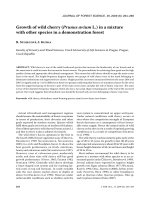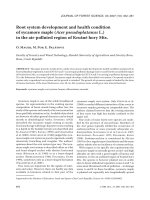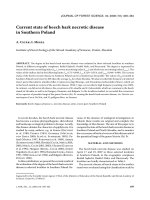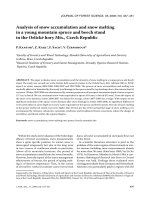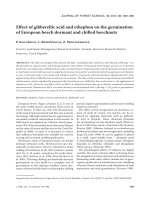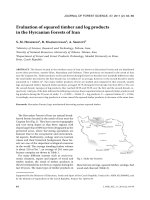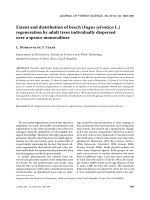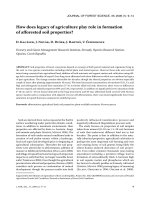Báo cáo lâm nghiệp:"Root biomass distribution under three cover types in a patchy Pseudotsuga menziesii forest in western Canada" pptx
Bạn đang xem bản rút gọn của tài liệu. Xem và tải ngay bản đầy đủ của tài liệu tại đây (1.4 MB, 6 trang )
469
Ann. For. Sci. 60 (2003) 469–474
© INRA, EDP Sciences, 2003
DOI: 10.1051/forest:2003040
Original article
Root biomass distribution under three cover types
in a patchy Pseudotsuga menziesii forest in western Canada
Andrew D. RICHARDSON
a
*, Catherine BEALLE STATLAND
b
, Timothy G. GREGOIRE
a
a
School of Forestry & Environmental Studies, Yale University, 370 Prospect Street, New Haven, CT 06511, USA
b
Research Branch, British Columbia Ministry of Forests, PO Box 9519, Stn. Prov. Govt., Victoria, BC V8W 9C2, Canada
(Received 7 October 2002; accepted 21 March 2003)
Abstract – We investigated the relationship between cover type and root biomass distribution and allocation to different root size classes in a
naturally regenerated, dry, Rocky Mountain Douglas-fir (Pseudotsuga menziesii var. glauca) forest in the southern interior of British Columbia,
Canada. The site was selectively harvested 32 years previously; residual stems were 30 cm and 130–170 years old at breast height at the time
of study. A total of nine pits (each measuring 1.0 m × 1.0 m) were excavated to a depth of 1.0 m under three different cover types: mature
timber, grassy (Calamagrostis rubescens) openings (canopy gaps), and regeneration clumps. Total (all diameters) live root biomass ranged from
4.7 kg/m
2
under the mature timber to 1.9 kg/m
2
under both regeneration clumps and grassy openings. Thin root (0.1 cm < φ ≤ 0.5 cm) biomass
was similar across all three cover types (0.8 kg/m
2
). We suggest that the similarity of thin root biomass across the three cover types is indicative
of strong root competition at this resource-poor site: there appears to be no below-ground “root gap” corresponding to the canopy opening above
the pinegrass-dominated patches.
Calamagrostis rubescens / Douglas-fir / gap / Pseudotsuga menziesii / root biomass
Résumé – Distribution de la biomasse racinaire sous trois types de couvert dans une forêt irrégulière de Pseudotsuga menziesii du
Canada occidental. Nous avons étudié la relation entre le type de couvert et la répartition de la biomasse racinaire entre différentes classes de
dimension des racines, dans une forêt sèche régénérée naturellement de Douglas des Montagnes Rocheuses (Pseudotsuga menziesii var. glauca)
située dans la zone intérieure méridionale de la Colombie Britannique au Canada. Cette station avait subi une coupe à la dimension 32 ans
auparavant. Les tiges restantes, âgées de 130 à 170 ans, avaient, au moment de l’étude, un diamètre à hauteur d’homme de 30 cm. On a creusé
neuf fosses mesurant chacune 1,0 × 1,0 × 1,0 m sous trois types de couvert : peuplement adulte, clairières à graminées (Calamagrostis
rubescens) et bouquets de régénération. La biomasse racinaire totale (tous diamètres) va de 4,7 kg/m
2
sous peuplement adulte à 1,9 kg/m
2
sous
les bouquets de régénération et sous clairières à graminées. La biomasse des racines fines (0,1 cm < φ ≤ 0,5 cm) était du même ordre sous les
trois types de couvert (0,8 kg/m
2
). Nous suggérons que cette similitude des valeurs de biomasse de racines fines entre les trois types de couvert
est l’indice de l’existence d’une forte concurrence entre racines, dans cette station pauvre en ressources. Les ouvertures dans le couvert forestier
se traduisent par des clairières à Calamagrostis qui ne sont pas des zones sans racines.
Calamagrostis rubescens / Douglas / trouée / Pseudotsuga menziesü / biomasse
1. INTRODUCTION
Plant roots, sometimes referred to as the “hidden half” [21],
are a major terrestrial sink for carbon [11]. For example, in
Douglas-fir (Pseudotsuga menziesii (Mirb.) Franco) stands,
roots may account for as much as one-fifth of total stand bio-
mass [5, 15], and it has been calculated that fine root turnover
represents 33% of global net primary productivity [9]. Further-
more, roots are important organs of competition, and in some
ecosystems, below-ground competition for resources may be
more important than that above-ground [3].
Root distribution parameters, such as root density or depth
profiles, are considered important indicators of below-ground
competition [3, 7]. Thus, variation in the distribution of roots
across a landscape may provide important information that
helps us to understand better the above-ground abundance and
distribution of species. For example, relationships between
above-ground canopy gaps and the availability of below-
ground growing space (the “root gaps” of Sanford [16, 17])
have been hypothesized but tested in only a few ecosystems [1,
4, 16, 17, 22].
Our study site, characterized by a continental climate with
warm summers and cool winters, was located in a dry Douglas-
fir forest (Fig. 1) in southern interior British Columbia, Can-
ada. We became interested in the correspondence between can-
opy openings and the availability of below-ground growing
space because of the patchy regeneration pattern of the domi-
nant tree species, Rocky Mountain Douglas-fir (Pseudotsuga
menziesii var. glauca (Beissn.) Franco), following a diameter-
limit harvest [20] at our site about thirty years ago. In the original
*
Corresponding author:
Present address: Complex systems Research Center, Morse Hall, 39 College Road, University of New Hampshire, Durham, NH 03824, USA.
470 A.D. Richardson et al.
multi-cohort stand, the distribution of trees of different ages
and sizes was very irregular. The selective harvest removed
most of the sparser patches of large trees and left denser
patches of undersize trees. Dense patches of Douglas-fir
regeneration subsequently occupied some of the created open-
ings, but not others, which were quickly overtaken by pine-
grass (Calamagrostis rubescens Buckl.). The canopy opening
above the pinegrass persists to this day, but little is known
about what is going on below-ground. Therefore, we exca-
vated three pits, each measuring one cubic meter, beneath each
of the three main cover types: mature timber, grassy openings,
and regeneration clumps. We compared the biomass distribu-
tion and allocation to different root size classes under these
three cover types.
2. MATERIALS AND METHODS
2.1. Study site
Field work was conducted in July 1998 near Merritt, British
Columbia (the westernmost Canadian province), in the north-east
corner of the B.C. Ministry of Forests’ Pothole Creek research site
(49° 55’ 22’’ N, 120° 27’ 37’’ W, elevation 1210 m). Pothole Creek
is situated within the interior Douglas-fir (IDF) biogeoclimatic zone
which dominates the south-central interior of B.C. Across the IDF
zone, the mean temperature is below 0 °C for 2–5 months of the year,
and above 10 °C for 3–5 months of the year; annual precipitation
ranges from 300 to 750 mm, of which up to half falls as snow [13].
Our study site is more properly classified as a dry, cool subzone (dk1)
of the IDF [12]; this subzone covers slightly more than half a million ha,
or just less than 1% of the forested landbase of the province of B.C.
The site is dominated by Douglas-fir, with occasional Pinus con-
torta Dougl. and hybrid Picea engelmannii × glauca. Dominant height
(the arithmetic mean height of the tallest 100 trees per ha) is 21.4 m.
Basal area of a 1 ha mensuration plot at the site is 22.4 m
2
/ha, with
the above-ground biomass of trees greater than 1.3 m in height esti-
mated to be 13.4 kg/m
2
(C. Bealle Statland and A.D. Richardson,
unpublished data). Small trees (≤ 12 cm diameter) account for about
14% of the basal area, and 7% of the above-ground biomass. The major
understory species is pinegrass; other undestory species include Shep-
herdia canadensis (L.) Nutt., Arctostaphylos uva-ursi (L.) Spreng., Aster
conspicuus Lindl., Achillea millefolium L., and Linnaea borealis L.
The site is characterized by three different cover types, which can
be classified as follows:
(1) mature residual Douglas-fir: The Pothole Creek site was selec-
tively harvested in 1966, and all of the dominant trees presently at the
site are residuals that were not harvested. Generally occurring
together in small stands, these trees average about 30 cm in diameter
and 130–170 years old at breast height. This mature timber is charac-
terized by little or no understory except for some pinegrass;
(2) dense Douglas-fir regeneration clumps: where regeneration
has occurred, trees are small (less than 5 m in height, though most are
considerably smaller) and up to 60 years old measured at base. The
younger trees have regenerated since the logging in 1966, and the
older trees were suppressed until the harvest opened up growing
space. Stem density is high, at times approaching 20 stems/m
2
. The
understory consists largely of Douglas-fir seedlings and some pine-
grass; and
(3) grassy openings: these are dominated almost exclusively by
pinegrass, and are notable for their absence of trees greater than 1.3 m
in height. There has been little or no Douglas-fir regeneration since
the harvest in 1966; if there was any suppressed regeneration prior to
the harvest, it has since been out-competed by pinegrass. Stumps
remaining from the harvest have been slow to decompose and are
scattered throughout these canopy gaps.
The cover types are abbreviated as M (mature timber), R (regen-
eration clumps), and G (grassy openings).
The soils at Pothole are coarse-textured (sandy loams with gener-
ally 5–10% gravels and 10–30% cobbles) and poorly developed, and
are classified (C. Braybrook, Ministry of Forests Research Branch,
Victoria, B.C., unpublished report) as predominantly Orthic melanic
brunisols or Eluviated eutric brunisols (FAO equivalent: Eutric Cam-
bisol). These are typical soils for dry forests in B.C. Soils at the site
are generally mildly acidic to neutral, with pH ranging from 5.7 to
6.8. In a preliminary study, soil properties did not appear to explain
whether harvested areas regenerated as Douglas-fir, or converted to
pinegrass (C. Braybrook, unpublished report).
2.2. Hydraulic excavation
We excavated three pits (1 m × 1 m × 1 m = 1 m
3
) under each of
the three cover types (Fig. 2). The use of coring techniques was
deemed inappropriate due to the abundance of cobbles and other
Figure 1. The Pothole Creek research site is character-
ized by mature Douglas-fir residuals from a selective
harvest some 30 years earlier (background), grassy
openings dominated by pinegrass (foreground), and
dense clumps of Douglas-fir regeneration (left edge).
Root biomass distribution in a patchy forest 471
coarse fragments in the soil. Pits were located in areas that appeared
representative of the appropriate cover type. Pits were hydraulically
excavated with a fire pump (Wajax Industries Ltd., Edmonton,
Alberta, Canada) powered by an 18 hp engine (Briggs and Stratton
Corp., Milwaukee, WI). The choice of hydraulic excavation tech-
niques restricted our excavation area to that which was within reach
of the hose, which was limited by the power of the pump and the loca-
tion and amount of the water supply. Excavation was conducted at
water pressures ranging from 350 to 600 kPa. Lower pressures were
adequate near the surface, where roots were most abundant and the
higher organic matter content resulted in a comparatively soft, loose
soil. Higher pressures (up to 1100 kPa) were generally required with
increasing depth, as the root density decreased and the difficulty of
excavation increased due to hard, cemented soil peds. The highest
pressures damaged or broke some roots of φ ≤ 0.5 cm (φ is mean root
diameter) but larger diameter roots generally remained intact; we do
not have any estimates available of the amount of biomass thus lost,
but we did not observe significant quantities of roots being carried
away in the hydraulic runoff.
In each pit, roots were collected and sorted into different size
classes based on mean root diameter. We used a modified system
based on the classification of Köstler et al. (1968) [10]: thin roots
(“Schwachwurzeln”, 0.1 cm < φ ≤ 0.5 cm), medium roots (“Grobwur-
zeln”, 0.5 cm < φ ≤ 2.0 cm), large roots (“Derbwurzeln”, 2.0 cm < φ ≤
5.0 cm), and very large roots (“Starkwurzeln”, φ > 5.0 cm). We did
not attempt to further subdivide thin roots or separate fine and very
fine roots; the thin root category thus includes fine roots. Dead and
decaying roots with φ > 0.5 cm were collected but not sorted by size
class. No attempt was made to separate roots by species.
Preliminary excavations indicated that the majority of the fine and
thin root mat was contained in the upper 20 cm soil horizon, and so
to differentiate surface roots from those occurring at deeper depths,
roots from the 0–20 cm and 20–100 cm horizons were separated. Fol-
lowing excavation, roots were oven-dried at 70 °C to constant weight.
2.3. Pit descriptions
Within 1 m of the edge of the pits under M, there were, on average,
2.7 mature Douglas-fir trees, with a mean diameter at breast height
(DBH) of 26.4 cm. Within 1 m of the edge of the pits under R, there
were, on average, 18.3 small (less than 5 m in height, but generally
much smaller) Douglas-fir stems. For pit G1, the nearest Douglas-fir
(25.6 cm DBH) was 6 m from the pit edge. For pit G2, the nearest
Douglas-fir (23.8 cm DBH) was 3 m from the pit edge. For pit G3,
there was a large, dense clump of old but quite small ( 5–10 cm
DBH) Douglas-fir about 5 m from the edge of the pit.
A basic description of the soil profile in each pit is given in
Table I. The abundance and size of coarse fragments varied with
depth and also among pits; coarse fragments were generally rare in
the upper 20 cm horizon, which was the approximate depth of organic
matter accumulation and also the zone of densest rooting. Two types
of coarse fragments were common: angular, blocky fragments resem-
bling shattered bedrock, and rounded cobbles more typical of glacial
till. Sample pit profiles are illustrated in Figure 3 for each cover type.
2.4. Statistical analysis
To test for differences in root biomass among different cover
types, we used a Monte Carlo type procedure (often referred to as a
“randomization test”) described by Schabenberger and Pierce (2001)
[19]. For each root diameter class, contrasts were constructed to com-
pare the mean biomass under each cover type against the mean of the
other two cover types combined. The significance of contrasts is
reported at two different levels, α = 0.05 and α = 0.10; the higher α is
accepted in some cases to reduce the likelihood of a Type II error. The
former was chosen because it has become the “gold standard” for
good or ill; the latter to increase the power of these tests [6].
3. RESULTS
3.1. Biomass by root size classes
On average, there was more total (live + dead) root biomass
beneath M (mature timber, 5.4 ± 1.5 kg/m
2
, mean ± 1 S.D.)
than R (regeneration clumps), and less under G (grassy open-
ings, 3.8 ± 1.0 kg/m
2
) (Fig. 4a; contrast between M and G, R
significant at P ≤ 0.10). Considering only live roots, however,
root biomass was nearly identical ( 2 kg/m
2
) for G and R, whilst
beneath M there was more than double that (4.6 ± 1.6 kg/m
2
,
Figure 2. Sketch map of the 0.1 ha corner of the Pothole Creek
research site where root excavations were conducted. Lines
represent approximate boundaries of the different cover types. Pit
locations under each cover type are indicated. Cover types: G,
Grassy opening; M, Mature forest; R, Regeneration clump.
≈
Figure 3. Sample soil profiles for one plot from each cover type.
(A) Grassy openings, plot G3; (B) Mature forest, plot M3;
(C) Regeneration clump, plot R3.
≈
472 A.D. Richardson et al.
Fig. 4b; contrast M vs. G, R significant at P ≤ 0.05). On a per-
centage basis, live roots accounted for 51%, 43%, and 85%,
respectively, of total root biomass beneath G, R, and M. The
variability in live root biomass, and hence total root biomass,
between plots was greatest beneath M, and least under R, as is
apparent from the scatter around each plot mean (Fig. 4).
The biomass of dead roots beneath M (0.8 ± 0.2 kg/m
2
)
tended not only to be lower but also much less variable com-
pared to the either G (1.8 ± 1.1 kg/m
2
) or R (2.7 ± 1.2 kg/m
2
).
The contrast between M and G, R was significant at P ≤ 0.05;
the contrast between R and M, G was significant at P ≤ 0.10.
Moreover, the distribution of dead root biomass in each of the
two depth classes was much more uniform for M than for
either of the other two cover types (CV% > 100% for 0–20 cm
for both G and R). Indeed, the great variability in dead root
biomass among plots under G and R makes inference about the
abundance of dead root biomass rather difficult.
Table II lists, by plot, the biomass allocated to different root
size classes. Thin root (0.1 < φ ≤ 0.5 cm) biomass was nearly
identical beneath all three cover types, and it varied little
within each type, irrespective of depth below ground. Aggre-
gate (0–100 cm depth) thin root biomass was highest under G
(0.9 ± 0.1 kg/m
2
) and lowest under M (0.7 ± 0.1 kg/m
2
), but
contrasts among cover types were not significant (all P > 0.10).
Medium roots (0.5 cm < φ ≤ 2.0 cm) had slightly less aggre-
gate biomass than thin roots (mean 0.7 ± 0.4 kg/m
2
across all
three cover types; Tab. II), but there was considerably more
variability in medium root biomass within G and M, when
compared to the distribution of thin root biomass. As with thin
roots, there were no significant contrasts among cover types
for medium roots (all P > 0.10).
The greater biomass in live roots under M (evident in
Fig. 4b) clearly is due to the greater abundance of large and
very large roots beneath this cover type (Tab. II). Mean large
root (2.0 cm < φ ≤ 5.0 cm) biomass (averaged across all three
cover types) was less than 0.5 kg/m
2
, and was consistently low
under R. Large root biomass under both G and M was some-
what larger but also more variable (0.5 ± 0.5 kg/m
2
under G
and 0.8 ± 0.6 kg/m
2
under M), but there were no significant
contrasts among cover types. Very large root (φ > 5.0 cm)
biomass was nonexistant under G and much lower under R
(0.5 ± 0.5 kg/m
2
) than M (2.1 ± 1.6 kg/m
2
). The contrast M vs.
G, R was significant at P ≤ 0.05 for very large roots. The vari-
ability of very large root biomass under M was much greater
than under either of the other two cover types.
Table I. Brief descriptions of soils in root excavation pits, grouped by cover type.
Pit # Depth Description
Mature clumps
M1 0–20 cm
20+ cm
high OM, few CF, abundant roots of all size classes
hard sand-silt, some large CF, few roots
M2 0–15 cm
15–50 cm
50+ cm
few CF, many roots of all size classes
many CF, hard sand-silt, few roots
abundant CF, very hard sand-silt, some large roots to depth of 1.0 m
M3 0–20 cm
20–40 cm
40–60 cm
60+ cm
high OM, few CF, soft sandy loam with many roots
some CF, few roots, hard sandy loam
many small CF, very hard sand-silt
coarse sand, angular CF of all sizes
Regeneration patches
R1 0–15 cm
15–90 cm
90+ cm
dark horizon with high OM, few CF, abundant roots
hard, compact horizon, mostly sand and silt, many small CF, some large CF
abundant roots spread out across impermeable layer of silt-clay
R2 0–20 cm
20–50 cm
50+ cm
dark horizon with high OM, few CF, abundant roots
silt-sand horizon, some coarse sand, few small CF, large CF common, few roots
hard, sandy horizon with few roots
R3 0–20 cm
20–50 cm
50–100 cm
100+ cm
dark, soft horizon with many roots
gravelly sand, many CF, few roots
hard, coarse sand with some gravel, abundant large and angular CF, and few roots
dense but thin layer of roots across top of impermeable silt-clay horizon embedded with rounded cobbles
Grassy openings
G1 0–100 cm
100+ cm
few CF, all small, soft sand-silt with many roots across entire profile
dense but thin layer of roots across top of impermeable silt-clay embedded with some larger CF
G2 0–10 cm
10–40 cm
40–80 cm
80+ cm
sandy horizon, some OM, abundant roots
hard layer of sand-silt, some CF
very hard, many angular CF to depth of 60 cm, few CF below 60 cm
dense but thin layer of roots across top of impermeable silt-clay
G3 0–30 cm
30–70 cm
70–100 cm
100+ cm
abundant roots in dark horizon with few CF
very hard horizon of gravelly, coarse sand, many large CF, some fine roots
some small CF, occasional fine roots
dense but thin layer of roots across top of impermeable silt-clay
Note: pit numbers correspond to those in Figure 2. Abbreviations: OM, organic matter; CF, coarse fragments (small: ≤ 5 cm; large: > 5 cm).
Root biomass distribution in a patchy forest 473
3.2. Root biomass by depth horizon
Summed across all four root size classes, and averaged
across all three cover types, 63% of total (to a depth of 100 cm)
live root biomass was contained in the 0–20 cm soil horizon,
suggesting a fairly shallow rooting habit (Tab. II). However,
this mean value hides the tremendous variability both within
and among cover types. For example, for both G (mean 72%)
and R (mean 80%), between 62% and 88% of the total live root
biomass of each plot was contained in the upper soil horizon,
whereas for M (mean 53%), the range was from 22% to 84%.
Within the different root size classes, greater disparities were
apparent. For example, whereas there was consistently 60–
70% of total thin root biomass in the 0–20 cm horizon, the dis-
tribution of very large roots was much more highly variable.
For one plot under M (and two plots under R), all very large
root biomass was in the 0–20 cm horizon, whereas for another
plot under M, all very large root biomass was in the 20–100 cm
horizon. In contrast, none of the plots under G had any very
large root biomass, in either of the horizons sampled (Tab. II).
4. DISCUSSION
Live root biomass may vary by as much as two orders of
magnitude across the world’s biomes, from 0.2 to 20 kg/m
2
[2,
8]. Jackson et al. (1996) [8] estimated an average root biomass
in temperate coniferous forests of 4.4 kg/m
2
. In our stands, due
mainly to differences in large and very large root biomass
among cover types, total live root biomass averaged 4.7 kg/m
2
under M, but was only 1.9 kg/m
2
under both G and R (the
greater biomass under M compared to R is consistent with the
idea that larger and more dominant trees contribute dispropor-
tionately to total below ground biomass in a stand [11]). Total
root biomass in a mixed-conifer (mostly Douglas-fir) forest in
New Mexico was reported to be 4.4 ± 0.7 kg/m
2
,
with φ ≤ 0.5 cm
root biomass accounting for 0.4 ± 0.1 kg/m
2
[5]. Root (φ <
0.5 cm) biomass of Douglas-fir in Oregon ranged from 0.8–
1.0 kg/m
2
[18], comparable to the average (across all three
cover types) of 0.8 kg/m
2
for thin root biomass at Pothole
Creek. In spite of the fact that root biomass is known to vary
considerably depending on species, climate, and soil condi-
tions [2, 8], our estimates are more or less in keeping with
these other studies.
In both G and M, roots with φ > 0.5 cm accounted for the
majority of total live root biomass, as has been shown for
Fagus sylvatica [11]. For example, thin roots in M accounted
for just 16% of total live root biomass.
Whereas temperate grasslands generally have 69% of root
biomass in the top 20 cm of soil, temperate coniferous forests
typically have only 38% in the top 20 cm [8]. Along with
deserts, temperate coniferous forests have the deepest rooting
profiles. At the Pothole Creek site, the top 20 cm of soil had a
much higher percentage of total live root biomass, ranging
from 53% under M to 80% under R. Root density under M at
the Pothole Creek site (12.3 kg/m
3
in the 0–20 cm horizon) was
about twice as high as that reported by Jackson et al. (1996) [8]
for temperate coniferous forests; root density under G (6.9 kg/m
3
in the 0–20 cm horizon) was similar to that reported for tem-
perate grasslands in the same study. Overall, the rooting pro-
files at Pothole Creek are quite shallow, especially in light of
the fact that within the IDF zone, growing season moisture
deficits are quite common [13].
Past results in both tropical [16, 17], and temperate [1, 22]
forests have shown that tree fall gaps not only result in canopy
openings, but also in the development of below-ground “root
Table II. Differences in root biomass (kg/m
2
) among different cover types, according to root size class and depth. Cover types: G, Grassy
opening; R, Regeneration clumps; M, Mature forest. Live root biomass is broken into different root diameter classes according a system
modified from Köstler et al. (1968): thin (0.1 cm < φ ≤ 0.5 cm), medium (0.5 cm < φ ≤ 2.0 cm), large (2.0 cm < φ ≤ 5.0 cm), very large (φ > 5.0 cm).
A ‘–‘ indicates that no roots of that size class were excavated from that particular pit.
Depth Root class
Pit code
G1 G2 G3 R1 R2 R3 M1 M2 M3
0–20 cm Dead
Total live
Thin
Medium
Large
Very la rge
–
2.37
0.65
0.82
0.90
–
0.07
1.04
0.54
0.14
0.35
–
2.74
0.71
0.58
0.13
–
–
0.06
1.95
0.54
0.40
0.16
0.84
0.56
1.13
0.44
0.36
0.34
–
2.05
1.59
0.53
0.34
–
0.71
0.08
3.55
0.41
0.91
0.24
1.99
0.35
0.89
0.36
0.42
0.11
–
0.36
2.94
0.53
0.28
1.52
0.62
20–100 cm Dead
Total live
Thin
Medium
Large
Very la rge
1.45
0.81
0.25
0.43
0.13
–
0.96
0.64
0.40
0.24
–
–
0.28
0.20
0.18
0.02
–
–
1.29
0.68
0.38
0.26
0.04
–
3.00
0.16
0.12
0.04
–
–
1.18
0.30
0.21
0.10
–
–
0.52
2.96
0.35
0.67
0.13
1.81
0.58
3.14
0.26
0.35
0.42
2.10
0.40
0.55
0.27
0.28
–
–
Total (to 100 cm)
Dead
Total live
Thin
Medium
Large
Very la rge
1.45
3.18
0.90
1.25
1.02
–
1.03
1.68
0.95
0.38
0.35
–
3.03
0.91
0.76
0.15
–
–
1.35
2.63
0.92
0.67
0.20
0.84
3.56
1.29
0.55
0.39
0.34
–
3.23
1.89
0.74
0.44
–
0.71
0.59
6.51
0.76
1.58
0.37
3.80
0.93
4.03
0.62
0.78
0.53
2.10
0.76
3.49
0.80
0.55
1.52
0.62
Total live + dead 4.63 2.71 3.93 3.99 4.85 5.12 7.11 4.96 4.25
474 A.D. Richardson et al.
gaps”, which are characterized by a sharp (but transitory)
reduction in fine root abundance. It is likely that the selective
harvest some 30 years ago at Pothole Creek also resulted in
some sort of “root gap” beneath the canopy openings. How-
ever, the similarity of thin root biomass across all three cover
types in the present study suggest that although the canopy
openings over G remain to this day, there are no corresponding
root gaps. We believe that our data support the idea that signif-
icant root competition is occurring at Pothole Creek: root com-
petition from pinegrass appears to be sufficiently intense that
tree regeneration is suppressed or out-competed.
The connection between canopy openings and root gaps is
of great importance to siliviculturists utilizing either partial
cutting or selection systems, where a primary concern is that
regeneration must be established before the available growing
space can be occupied by competing vegetation [20]. Directly
related to the present study, Petersen (1988) [14] demonstrated
the effects of pinegrass on Pinus ponderosa growth at a dry,
interior site in Montana, USA. Based on the results presented
here, we suggest that future management of sites similar to
Pothole Creek may necessitate (1) harvesting methods that
discourage grass invasion without discouraging natural tree
regeneration; or (2) prompt execution of artificial regeneration
(such as underplanting) to avoid excessive competition from
grass or shrubs.
Acknowledgements: Funding for this research was generously
provided by Forest Renewal B.C. and the British Columbia Ministry
of Forests. Thanks are due to Ken Mitchell for logistical support and
guidance, and Michelle McDonald and Greg Hodson for help with
the excavation. David Skelly, Oswald Schmitz, and Michael Booth
provided helpful comments on drafts of the manuscript. We are
especially indebted to Michael Drexhage for his suggestions for
improvement.
REFERENCES
[1] Bauhus J., Bartsch N., Fine-root growth in beech (Fagus sylvatica)
forest gaps, Can. J. For. Res. 26 (1996) 2153–2159.
[2] Cairns M.A., Brown S., Helmer E.H., Baumgardner G.A., Root
biomass allocation in the world's upland forests, Oecologia 111
(1997) 1–11.
[3] Casper B.B., Jackson R.B., Plant competition underground, Annu.
Rev. Ecol. Syst. 28 (1997) 545–570.
[4] Cavelier J., Estevez J., Arjona B., Fine-root biomass in three
successional stages of an Andean cloud forest in Colombia,
Biotropica 28 (1996) 728–736.
[5] Gower S.T., Vogt K.A., Grier C.C., Carbon dynamics of Rocky
Mountain Douglas-fir: Influence of water and nutrient availability,
Ecol. Monogr. 62 (1992) 43–65.
[6] Gregoire T.G., Driver B.L., Type II errors in leisure research, J.
Leis. Res. 19 (1987) 261–272.
[7] Hendriks C.M.A., Bianchi F.J.J.A., Root density and root biomass
in pure and mixed forest stands of Douglas-fir and beech, Neth. J.
Agric. Sci. 43 (1995) 321–331.
[8] Jackson R.B., Canadell J., Ehleringer J.R., Mooney H.A., Sala
O.E., Schulze E.D., A global analysis of root distributions for
terrestrial biomes, Oecologia 108 (1996) 389–411.
[9] Jackson R.B., Mooney H.A., Schulze E.D., A global budget for fine
root biomass, surface area, and nutrient contents, Proc. Natl. Acad.
Sci. USA 94 (1997) 7362–7366.
[10] Köstler J.N., Brückner E., Bibelriehter H., Die Wurzeln der
Waldbäume, Parey Verlag, Hamburg, 1968.
[11] Le Goff N., Ottorini J M., Root biomass and biomass increment in
a beech (Fagus sylvatica L.) stand in North-East France, Ann. For.
Sci. 58 (2001) 1–13.
[12] Lloyd D., Angove K., Hope G., Thompson C., A guide to site
identification and interpretation for the Kamloops forest region,
Research Branch, Ministry of Forests, Victoria, B.C., 1990.
[13] Meidinger D., Pojar J. (Eds.), Ecosystems of British Columbia,
Research Branch Special Report Series No. 6, B.C. Ministry of
Forests, Victoria, B.C., 1991.
[14] Petersen T.D., Effects of interference from Calamagrostis
rubescens on size distributions in stands of Pinus ponderosa, J.
Appl. Ecol. 25 (1988) 265–272.
[15] Ranger J., Gelhaye D., Belowground biomass and nutrient content
in a 47-year-old Douglas-fir plantation, Ann. For. Sci. 58 (2001)
423–430.
[16] Sanford R.L., Fine root biomass under a tropical forest light gap
opening in Costa Rica, J. Trop. Ecol. 5 (1989) 251–256.
[17] Sanford R.L., Fine root biomass under light gap openings in an
Amazon rain forest, Oecologia 83 (1990) 541–545.
[18] Santantonio D., Hermann R.K., Overton W.S., Root biomass
studies in forest ecosystems, Pedobiologia 17 (1977) 1–31.
[19] Schabenberger O., Pierce F.J., Contemporary statistical models for
the plant and soil sciences, CRC Press, Boca Raton, FL, 2001.
[20] Smith D.M., Larson B.C., Kelty M.J., Ashton P.M.S., The practice
of silviculture: Applied forest ecology, 9th ed., Wiley, New York,
1997.
[21] Waisel Y., Eshel A., Kafkafi U. (Eds.), Plant roots: the hidden half,
Marcel Dekker, New York, 1996.
[22] Wilczynski C.J., Pickett S.T.A., Fine root biomass within
experimental canopy gaps: Evidence for a belowground gap, J.
Veg. Sci. 4 (1993) 571–574.
Figure 4: (a) Total (live + dead) and (b) live root biomass (kg/m
2
) in
each of the nine pits excavated, separated by cover type. Faint hori-
zontal lines indicate the mean value across all three cover types. Hea-
vier, short lines indicate means within each cover type. In Figure 4b,
values next to each mean indicate the percentage of total root bio-
mass that was accounted for by live roots within that cover type.

